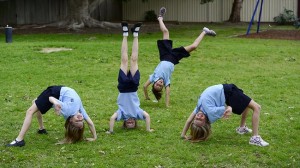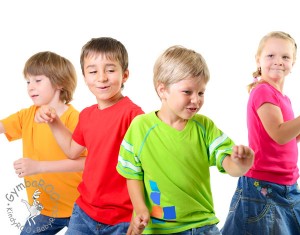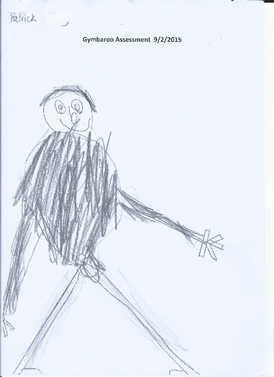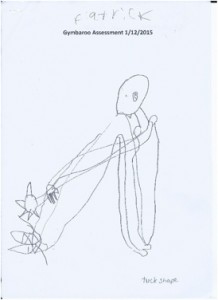Join the thousands of parents already raising smarter, happier babies with our online baby classes: The Active Babies Smart Kids series. Click here.
GymbaROO-KindyROO kids are excelling academically, emotionally, in leadership roles and on the sporting field. Find us at: GymbaROO-KindyROO
Dr Jane Williams and Bindy Cummings
A new study involving 400 Australian Primary school students has added irrefutable proof to the argument that motor skill based movement programs are crucial for brain development and learning ability and should play a key role in our education system. In this study the average neurological age of the children participating in the movement program increased by an average of nearly TWO YEARS in the 10-12 month testing period. Conversely, the non-participating group improved their average neurological age by ONLY SIX MONTHS over the same time period. The movement classes were run in place of literacy or numeracy sessions.
 Designed by GymbaROO-KindyROO, The Unlocking Potential (UP) movement program is a sensory-motor-perceptual program for primary schools. It proposes to unlock the potential for all children.
Designed by GymbaROO-KindyROO, The Unlocking Potential (UP) movement program is a sensory-motor-perceptual program for primary schools. It proposes to unlock the potential for all children.
At the end of the testing period, not only was there a dramatic improvement in learning ability in the UP cohort, teachers also reported significant improvement in classroom attention and behaviour, social skills and behaviour in the playground.
This is not the first time the UP program has been implemented with outstanding results. In 2008, UP was trialed, specifically studying the effects of the movement program on literacy and speech in primary school aged children.1 Teachers reported that the program resulted in improved in literacy, concentration and the ability to follow instructions. The Government of the time chose to ignore these findings. Link to ‘No child should fail’ study.
This year another smaller study involving Primary school children and the UP program clearly showed improved academic achievement, NAPLAN results, behaviour, physical, social and emotional skills and overall happiness at school.2 Teachers also reported an increase in self-esteem, confidence and social interaction, physical control in the playground as well as a willingness to attempt new tasks and to take on the responsibility for their own learning. Link here.
One does need to ask, is ignoring these results and holding off the implementation of sensorimotor movement programs in Primary schools doing our children, their futures and the future of our country a gross disservice?
The UP program – not just a fitness program
According to recent research, physical activity programs for children should, initially, focus more on developing motor skills rather than physical fitness, allowing the maturation and integration of all areas of the neurological system that prepare the child for the challenges of school learning as well as physical capacity and ability. Once these are in place, fitness can then become the focus.3
Unlocking Potential (UP) is a unique neuro-developmental movement program that focuses on this motor skill development and draws on the latest neuro-developmental research to assist the stimulation of brain development important to learning, physical skills and behaviours.
The UP program is designed to train teachers in assisting students to ensure baseline motor skills, that provide the foundation for more complex physical skills are in place and to help students to reach their optimum level of both mental and physical function.
Importantly, most of the students involved with UP found the program motivating and enjoyable, which encouraged performance of the developmental exercises and activities.
The weight behind why our children need movement programs
 Regular physical activity has long been associated with improving physical health, cardiovascular fitness, reducing weight and, more recently, with enhancing brain health.4 Conversely, sedentary lifestyles are on the increase across all age groups. In Australia only 19% of 5 -14 year old children get the recommended 60 minutes of active exercise each day.5
Regular physical activity has long been associated with improving physical health, cardiovascular fitness, reducing weight and, more recently, with enhancing brain health.4 Conversely, sedentary lifestyles are on the increase across all age groups. In Australia only 19% of 5 -14 year old children get the recommended 60 minutes of active exercise each day.5
Reduced physical activity is further exacerbated during school hours as the educational sector strives to improve numeracy and literacy results by increasing the focus on academic classroom-based strategies and reducing opportunities for active play at school.6
This is despite research that increasingly reveals the link between motor development and cognitive skills7. Regular sensorimotor movement exercises in school aged children has been shown to improve executive function,8 working memory,9 cognitive control,10 attention,11 behaviour in the classroom and playground,12 and academic performance.13
The study
314 students from four Australian Primary Schools participated in UP sessions for 25 minutes at the beginning of the school day, three days a week during each school term over the year period 2014 – 2015. Additionally, 86 children had teachers that chose not to participate for a number of reasons, including the ‘already crowded curriculum’ or a lack of interest in the program. UP classes were run at a time that had been historically been allocated to literacy or numeracy sessions.
Outcomes were measured pre and post implementation, by Naglieri’s Draw a Person assessment. This is a validated and reliable instrument for determining improvements in a child’s neurological age and stage. This tool simply and efficiently determines a child’s awareness of their own body through self-drawing, an essential element that underscores both physical and mental health. Research has shown that DAP drawings in the young child are directly correlated to IQ at 14 years of age.14
Outcomes
- The UP participating group significantly improved their average neurological age by 22 months in the 10-12 month testing period. Conversely, the non-UP participating group improved their average neurological age by only 6 months in the 10-12 month period.
- At pre-test, 17% of UP participating children were performing well below the level of ability expected for their age and stage of development and that is essential for learning success. At post-test only 4% of children were severely under-performing. In contrast, only 7% of non-UP participants were performing well below the level of ability expected for their age and stage of development at pre-test, but this number increases to 13.5% by the post-test.
- Percentile ranking shows that in the UP cohort, 17.5% of children were performing well above that of peers of the same age in the pre-test. Post-test this figure increased to 40%. In the non-UP cohort, the percentage of children achieving in the highest percentile ranks remains stable at the pre and post-tests (25% and 27%).
For more outcomes see full report.

You can see the enormous gains to Patrick’s neurological age – over 3 years in a 10 month period.
What it all means
- These results indicate that children who participate in the UP program can significantly improve their neurological development and consequently, their ability to learn at school.
- Significant gains have been made by many children in the UP group, however there are indications that some children still require time to mature neurological pathways and an additional daily UP would prove valuable for these children.
- Even children who are achieving satisfactorily benefit from regular participation in the UP program.
- For the sake of our children, today’s Governments need to immediately get behind future studies and the implementation of sensory movement based programs such as UP in our Primary schools.
Download full report by Dr Williams here.
References: 1.Mirabella, Sasse & Schreiver ‘No child should fail’, 2008. 2.Williams 2013; 2015. 3.Burdette & Whitaker 2005, Melillo & Leisman 2004, Bar-Or & Malina 1995. 4.Kramer & Erikson, 2008; Hillman, Erickson & Kramer, 2008; Voss et al. 2011, Diamond 2013. 5.Active, Healthy Kids Australia 2014.6.Diamond 2000; Sibley & Etnier 2003. 7.Hillman et al, 2009, 2014; Davis, Pitchford & Limback 2011. 8.Kamiijo et al. 2011. 9.Chaddock et al. 2012a; Chaddock-Heyman et al. 2013; Fedewa & Ahn 2011; Etnier et al. 1997. 10.Hill et al. 2010. 11.Pontifex et al. 2013. 12.Reynolds & Nicolson 2006; Castelli et al. 2007; Tomporowski et al. 2008; London & Castrechini 2011; Pontifex et al. 2013. 13.Burdette & Whitaker 2005, Melillo & Leisman 2004, Bar-Or & Malina 1995. 14.Arden, Trzaskowski, Garfield & Plomin 2014.
Dr Jane Williams (PhD, BMgt, RN(Paeds)) is the Research and Education General Manager for GymbaROO and KindyROO. Dr Williams is one of Australia’s leading experts on baby and child development. More on Dr Williams here.
Bindy Cummings (B.Ed(Human Movement) Hons) has worked as a teacher, child development consultant, early childhood development lecturer, teacher trainer and INPP & iLS consultant. She is the co-creator of GymbaROO’s Active Babies Smart Kids online series, has authored many published articles on child development. She is working on the content and development GymbaROO’s portal and online training programs, and the creation of new online programs for parents and children. More on Bindy Cummings here.
GymbaROO-KindyROO
Thousands of parents, babies and children are presently involved in our programs and creating rising stars. GymbaROO-KindyROO kids are excelling academically, emotionally, in leadership roles and on the sporting field. Come join all the fun and learning! “GymbaROO – The best decision I ever made for my child.” Classes from 6 weeks old – 7 years GymbaROO KindyROO
Enjoy the following GymbaROO-KindyROO articles
GymbaROO-KindyROO: Who, what, where, why and how
All about GymbaROO-KindyROO’s online baby classes for parents and babies: Active Babies Smart Kids
Why active babies make smart kids
Become a GymbaROO-KindyROO franchisee
NAPLAN results improve with LESS reading and maths and MORE physical activity.
To my elected childcare, preschool or school: Please include a GymbaROO sensorimotor program.
School Readiness: Is my child ready for school? A checklist
Why GymbaROO kids excel academically.
Why GymbaROO kids excel at the three R’s – wRiting, Reading, aRithmetic (maths).
Why GymbaROO kids excel at sport.
Why GymbaROO kids excel socially and in leadership roles.
Recent research demonstrates the importance of early movement experiences to academic achievement.
He May Not ‘Grow Out of It’. A Checklist for Parents of 0 – 5 Year Olds.
The skills needed for writing begin in infancy. What parents can do.
Click here for more GymbaROO-KindyROO article choices
Active Babies Smart Kids – Online Baby Classes
GymbaROO-KindyROO’s online series of baby classes is taking the parenting world by storm! It is highly recommended by doctors, paediatricians, early childhood experts and the Maternal Child and Family Health Nurses Association. This series is being called: “The essential guide for parents”. Join the thousands of parents already playing with their babies from birth, in the best way for brain and body development and laying crucial foundations for future learning. What happens in the first year, not only matters, it matters a lot! See Introductory video below.
Active Babies Smart Kids online series – Click here.
Try the first class FREE! Click here to watch our Active Babies Smart Kids Episode 1 – Tummy Time




